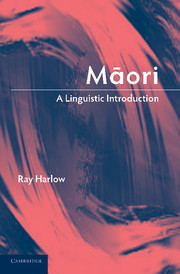Book contents
- Frontmatter
- Contents
- List of figures
- List of maps
- List of tables
- Acknowledgements
- List of abbreviations
- Introduction
- 1 Māori literature and literature on Māori
- 2 A brief history of Māori
- 3 Regional variation in Māori
- 4 The phonology of Māori
- 5 The morphology of Māori
- 6 The syntax of Māori
- 7 The sociolinguistic situation of Māori
- References
- Index
1 - Māori literature and literature on Māori
Published online by Cambridge University Press: 28 January 2010
- Frontmatter
- Contents
- List of figures
- List of maps
- List of tables
- Acknowledgements
- List of abbreviations
- Introduction
- 1 Māori literature and literature on Māori
- 2 A brief history of Māori
- 3 Regional variation in Māori
- 4 The phonology of Māori
- 5 The morphology of Māori
- 6 The syntax of Māori
- 7 The sociolinguistic situation of Māori
- References
- Index
Summary
Māori is not the Polynesian language for which we have the oldest written records; that honour goes to Niuatoputapu and East Futunan. However, it is the subject of substantial documentation over the last 200 and more years. Over the same period, Māori has become a written language, not only through such documentation, but also through the transcription of its rich oral tradition and its use in the nineteenth century, and again increasingly in the present, in domains which are typically literate.
Chapter 4 will sketch the development of the writing system now used for Māori. What this chapter will present is an account of the documentation of Māori since first contact with Europeans, and of the nature of Māori literature, traditionally oral, but in recent times forming an ever increasing, and ever diversifying, written corpus.
Literature on Māori
As noted, Māori is one of the best-documented of the Polynesian languages with written sources on the language dating from the earliest contact period. Word lists compiled during James Cook's first voyage (1769–70) are simply the first of many such documents (see chapters 3 and 4). The first fuller documentation of the language was also the first publication in or on Māori (Kendall 1815). This was an attempt to provide a resource for Thomas Kendall's missionary colleagues and contains alphabets (rejoicing in the title Na Letteree), word lists and expressions.
- Type
- Chapter
- Information
- MaoriA Linguistic Introduction, pp. 5 - 9Publisher: Cambridge University PressPrint publication year: 2007



